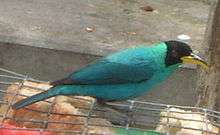Asa Wright Nature Centre

The Asa Wright Nature Centre and Lodge is a nature resort and scientific research station in the Arima Valley of the Northern Range in Trinidad and Tobago. The centre is one of the top birdwatching spots in the Caribbean; a total of 159 species of birds have been recorded there. The centre is owned by a non-profit trust.
The nature centre is on 270 acres and includes a main estate house with inn and restaurant serving dishes such as callaloo soup with ingredients from an on-site organic garden.[1] Non-adjacent properties have also been added to the centre's land holdings.
Description

The major properties are the Spring Hill Estate and the adjacent William Beebe Tropical Research Station (also known as Simla), which was established by the famous naturalist and explorer William Beebe as a tropical research station for the New York Zoological Society. Beebe bought the 'Verdant Vale' estate in 1949 and named it after Simla in India, which he had visited in 1910.[2] Both properties had previously been cacao estates but contained large stands of original rainforest. The owners of the Spring Hill Estate, Newcombe and Asa Wright, hosted many visiting scientists in the 1950s and '60s, including the noted ornithologists David Snow and Barbara Snow, who made detailed studies of the oilbirds and the very complex courtship dances of the white-bearded manakin and the golden-headed manakin.
The Wrights' home became internationally renowned for its easy access to wildlife, especially the oilbird (Steatornis caripensis) colonies in the nearby Dunston Cave, and large numbers of hummingbirds. After the death of Newcombe Wright in 1967, the Spring Hill Estate was acquired by a non-profit trust.[3] Asa Wright continued to live at the centre until her death in 1971. In 1974, the New York Zoological Society donated Simla to the trust.[4]
The nature centre in 2001 acquired the Rapsey Estate, known as 'El Naranjo' in the Aripo Valley, just west of the Arima Valley for TT$3,3 million. The total nature centre holdings are now over 1,300 acres (526 hectares), but this still makes up less than 5% of the valley.[5]
Wildlife
The centre is one of the most biodiverse areas in the West Indies and is home to more than 400 bird species. Bird species at the nature centre include purple honeycreeper, tufted coquette (a hummingbird), tropical mockingbird, and oilbird (a nocturnal fruit eater).[1]
Red brocket deer as well as the elusive ocelot can be seen in the nature centre's trails. Agouti is also a common animal that occurs in the centre.
Gallery
-

-

On the veranda
-
Waterfall in the grounds
-
Heliconia 'Sexy Pink' in the grounds
-

Green honeycreeper at the feeders
-

Fruit bats at the feeders
-

Jocelyn Crane visiting Centre c. 1960
Footnotes
References
- ffrench, Richard (1991). A Guide to the Birds of Trinidad and Tobago (2nd ed.). Comstock Publishing. ISBN 0-8014-9792-2.
- Gould, Carol Grant (2004). The Remarkable Life of William Beebe. Washington DC: Island Press. ISBN 1-55963-858-3.
- Herklots, G. A. C. 1961. The Birds of Trinidad and Tobago. Collins, London. Reprint 1965.
- Linblad, Jan. 1966. Journey to red birds. Trans. by Gwynne Vevers. Reprint: Collins, London. 1969.
- Rudder, Joy (2009). The old house and the dream: The story of The Asa Wright Nature Centre. Prospect Press, Media and Editorial Projects Limited, Maraval, Port of Spain, Trinidad. ISBN 976-95082-1-7.
- Snow, D. W. 1956. "The dance of the Manakins." Animal Kingdom (59) 3: pp. 86–91.
- Zahl, Paul A. 1954. Coro-Coro: The World of the Scarlet Ibis. Bobbs-Merrill, Indianapolis / New York.
- Worth, C. Brooke. 1967. A Naturalist in Trinidad. J. B. Lippincott Company, Philadelphia and New York.
External links
| Wikimedia Commons has media related to Asa Wright Nature Centre. |
Coordinates: 10°42′N 61°18′W / 10.7°N 61.3°W
